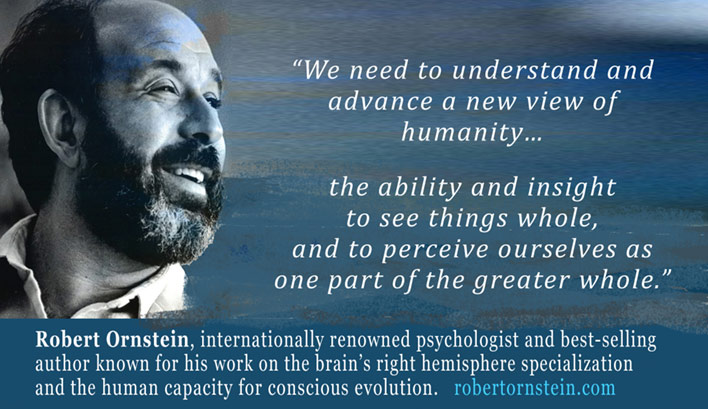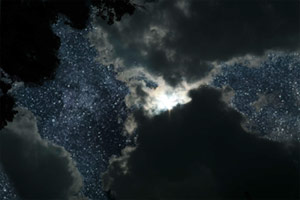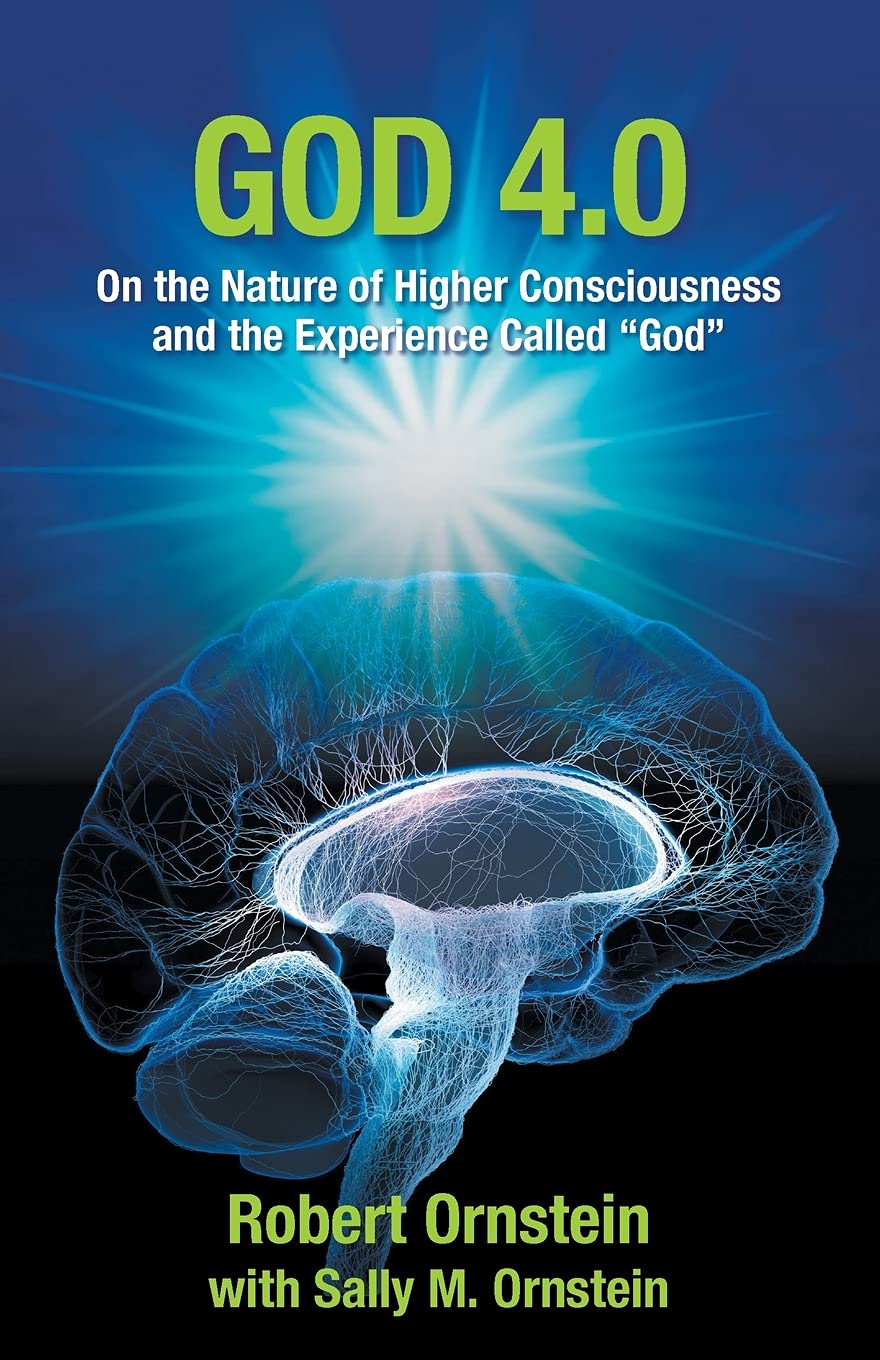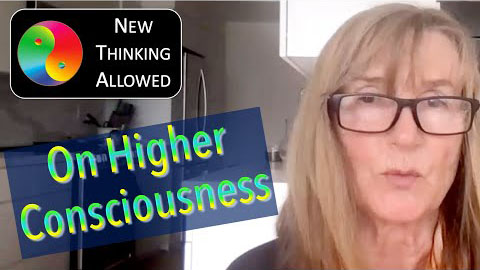Featured Book
God 4.0
On the Nature of Higher Consciousness and the Experience Called “God”
Robert Ornstein with Sally M. Ornstein
Paperback edition 2021
Review by Denise Winn
Contributing Writer
“What is needed, now, is a new view, to reassess and reform the concept of God. It is the experience of going beyond the norm to achieve insight as to how life events are connected on a “higher” level. We now have an idea of how the process happens in the brain and, importantly, how to develop this innate potential in today’s world. This knowledge could be the first small step toward finding the common ground for us to stand on to work toward a new spiritual literacy.”
— Robert Ornstein
This is an abridged extract from God 4.0: On the Nature of Higher Consciousness and the Experience Called “God,” by Robert Ornstein with Sally M. Ornstein. An extended version of it appears in the December 2021 issue of “Human Givens Journal.” It was reprinted with the kind permission of Malor Books.
There is a new understanding about how human beings have been trying to “seek God” from the time of the Paleolithic to now, from Boston to Tasmania. Countless research findings reveal the existence of a second network of cognition that transcends everyday consciousness. It is what people have tried to activate, from the earliest shaman-sages to Moses 3,500 years ago, to Jesus 2,000 years ago, to Muhammad 1,400 years ago, all the way up to the myriad of contemporary seekers.
To understand when, how and why this activation can happen, we consider how people have achieved these changes of consciousness over three historical phases that we call God 1.0, God 2.0 and God 3.0 — from the shamans to the prophets, from the Paleolithic era to the Axial Age and to the origins of the major monotheistic religions.
We set out to show that what has been thought of traditionally and described metaphorically as “knowing God” is a special mode of perception, a development of cognition that opens an extra dimension usually dormant in consciousness. Unfortunately, the heritage of this “second network” activation is more than a bit muddled, as our society is left with the followers of the original sages who, through countless generations, have interpreted, reinterpreted, distorted and even replaced the prophets’ transcendent insights with sets of rules made up in the cultures of many different eras. As a result, dogma and bureaucracy have replaced the original innovation and insight. This has created needless conflict and destructive hostility between different sects, and between “science” (even its modern developments) and “spirituality.”
Identifying the experience some have called God as a conscious perception should not be understood as a reduction of “heavenly” experiences but as a deflation of a fantasy.
Our ancestors lacked accurate understanding of human nature, human cognition and physiology, so they did not have the knowledge base or the language to describe their experiences or attribute them correctly. Instead, religions and spiritual groups have used metaphors – as we do, when we link stars together into a pattern. Although we see Orion as “the hunter,” this is an illusion on many levels. For one thing, Orion’s stars range from 243 to 1,360 light-years away from us, but we see them on a single plane, joined together as a unit. Other cultures see other forms in this constellation; for instance, the Lakota of North America see an outstretched hand; the Aboriginal people of Western Australia’s Great Victoria Desert see a different hunter, Nyeeruna, pursuing the Yugarilya (sisters of the Pleiades) but prevented from reaching them by their eldest sister, Kambugudha (the Hyades star cluster).
Identifying the experience some have called God as a conscious perception should not be understood as a reduction of “heavenly” experiences but as a deflation of a fantasy (as is our imagination of the stars’ arrangements). It is a correction of the many literal interpretations of metaphors that have dragged on for millennia, taking us along as passengers. It corrects our understanding of terms that have come down to us, such as “angels,” “Heaven and Hell” and “Son of God,” themselves metaphors based upon other metaphors.
The transcendent experience has been misunderstood, mistreated and, very often, deliberately misconstrued for social and even sexual control, and for political ends. We simply have not had the framework to understand it until now, and whole societies have grown up around this fundamental lack.
We don’t experience the world as it is, but as a virtual reality.
Fortunately, since the end of World War II, we’ve gained a revolutionary amount of scientific understanding about our place in the universe, about our brains and minds, how they operate, and about our potential.
We now know how our “everyday” mind works as a device for selecting just a few parts of the outside reality that are important for our survival. We don’t experience the world as it is, but as a virtual reality — a small, limited system that has evolved to keep us safe and ensure our survival. This small everyday world is what the prophets and teachers throughout history have advised us “to shun” – to go beyond.
There is always some skepticism surrounding the assertion that personal experience is central to knowledge. And there are also thoughtful, though mistaken, interpretations as to what the personal experience means. The studious but extreme religious conservative literalist, New York Times columnist Ross Douthat, feels that “. . . the Gnostic/God within [point of view] makes every individual into his own Chosen Person, with his own private Yahweh somewhere deep inside.”
Douthat mischaracterizes what an authentic experience of conscious connectedness would offer. While of course there are some who are like his characterization of self-ish superiority, the genuine experience is the development of a self-less consciousness of the unity of life. The result is connection and solidarity with others — not an elitist “chosen people” or egocentric monomania. It is not about possessing a personal Godlet or Godlette within, but perceiving the without within. This is something different, and it is why we need the fresh start.
The Turn in Science
What we consider modern religions developed five to 1.5 millennia ago, when the principals didn’t know about weather systems or cosmology – what was in the sky – or the geologic age of the Earth. They didn’t know that the brain is involved in thought and the control of the body, or that genes influence our development.
Human beings evolved to go beyond the individual, this is the basis of our planetary success.
When Joseph Bogen surgically split the two hemispheres of the brain (the famous “split-brain” operation), the patient’s ability to connect objects to a whole was gone in one side. When things are connected, they are attached; they become a part of each other, a whole, and they operate in unison. Connectedness yields wholeness and unity, important aspects of consciousness. The right hemisphere, in most people, is highly involved in producing and maintaining this overall comprehensive outlook. The best way to think about the relationship between the left hemisphere and the right hemisphere is as one between the text (the literal statement itself, alone) and the context (the meaning, taking in all the information as a whole).
That perception of a larger whole is the wellspring of humanity’s solidarity in tribes, societies, teams, nations and religions. It is not the possession of any religion or sect and it is not a delusion. The complement of brain structures and social development necessary for this group solidarity forms the deep basis of a sense of something beyond and, sometimes, of a “God.” Human beings evolved to go beyond the individual, to transcend the “self” and to connect in a manner that no other organism can – and this is the basis of our planetary success.
Confusing language
There are plenty of reasons why bright, intellectually oriented people reject or ignore the “transcendent.” For one thing, we’ve outgrown the language. Many words used in antiquity no longer have the same meaning. For instance, the word “spiritual” traditionally meant “of the soul” (referring to a higher perceptive capacity); today it is often confused with deep feeling. The word “transcendence” itself can evoke the idea of escaping from life and its difficulties, floating away to a warm and fuzzy safe space. But transcendence really means shifting one’s state of consciousness to achieve a new insight, perceiving the connections between formerly unrelated happenings, objects and events.
We usually conceive of a common connection between spirituality and religion, but there is a clear separation between the two – in concept, in practice and even between their practitioners. Spirituality more often entails the person leaving their received doctrine behind to search for something “beyond,” while religion most often involves following a received tradition and its rules laid down for established behaviors. The word “mysticism” sounds a bit strange, too. It derives from the church’s medieval “mystery plays.” Metaphysics, which also sounds like something filmy and beyond the realm of reality, is just Aristotle’s name for the next book in a sequence he was writing, the one “after” physics (meta-physics) where he took on these issues.
It is imperative to either rescue or do away with these archaic terms and to clarify the importance and the reality of the phenomena they refer to. Otherwise, it is as if we were to hear a thunderstorm being described as a god’s angry voice and then believe that, if we went outside, we wouldn’t get soaked.
There is also a lot else to try to put together and to understand. Why do people all over the world have “high” experiences? Why do they build soaring structures to stimulate awe? Why do people, in transcendent moments, have such similar experiences of timelessness, spacelessness, placelessness and a sense of nothingness? What could those terms mean, and why are they universal?
People who abhor social, religious or political change are somewhat prewired (though not hardwired) to be fundamentally conservative.
And, why do people do and say crazy, incomprehensible things? All over the world, people seeking higher experiences might focus on a sound, phrase or image for an hour; they might dance to exhaustion; synchronize spinning movements; endure deprivation and pain; fast; stimulate a trance state; put ash on their faces; or wear clothes suitable for a Middle European winter in the sweltering heat of a Jerusalem summer. We hear the statement, “The world is an illusion” and have little idea what that might mean. It’s all too easy to dismiss, if you don’t know what the speakers are talking about (and, all too often, they themselves don’t know).
We all possess inherent cognitive biases ranging from reliance on strict, sequential methods of examining information (often called, mistakenly, rationality) to an all-at-once manner of thought involving diffuse and loose associations. Where we are on this continuum underlies how open we are to new ideas and experiences, versus being tethered and fixed to doctrinaire interpretations of the saying of venerated ancestors. These biases affect everything from our idea of God, to our religious and political affiliations, to our preference for open versus closed borders of our country. People who adhere strongly to one or another cognitive style have a genetic predisposition to do so. People who abhor social, religious or political change are somewhat prewired (though not hardwired) to be fundamentally conservative: to keep things as they are or as they believe they were in the paradisiacal Muhammadan Caliphate, in the church of the Council of Nicaea, in the colonial world of the original Constitution, or even in the days of late 1950s European royalty. We observe this cast of mind all over the world today.
The public discussion of spirituality is often dominated (as it is in politics) by the extremes: one side maintains that the whole thing is an illusion – an old-fashioned superstition, while the other side maintains that God is everywhere, always, and sees and guides everything. Transcendence, then, seems alien and a waste of time to the minds of many. To those with very ordered minds, people interested in the possibility of transcendence can seem flakey, prone to magical thinking and less able to use structured logic. And there is, in truth, a strong association between an individual’s interest in spirituality and a certain fluidity of thought – too much of which can be maladaptive, just as too much rigidity can lead to obsessive-compulsive disorder and the like. A precise, mechanistic, “engineering” approach to comprehend the world’s workings may provide consistency and repeatability that is great for technical progress, but it can foreclose on our openness to new experiences and new ideas.
A Second System
We have a “second system” which is not a physical organ or a specific set of cells in the brain that underlies, for example, the ability to speak a language. But it is evidently present. It is a quiescent faculty; accidents can activate it, as can certain procedures, such as meditation, isolation, fasting, overstimulation, prayer and the use of drugs, which have appeared in every known society. They all involve a breakup or a bypass of normal cognition, and the opening of “another world,” as it has been called metaphorically.
All of us possess a nascent, intuitive sense, which is the basis of an expanded consciousness.
We now know how the mind and brain do this, and for the first time, we can explore how this innate mode of cognition can be activated in a way relevant to the rapidly changing modern world.
The capacity for this development is a part of everyone’s natural endowment. All of us possess a nascent, intuitive sense, which is the basis of an expanded consciousness; but it is not fully developed in most of us, just as a lot of other human capacities lie embryonic and untrained. All human beings can speak and understand language, but to write it and read it demands a lot of teaching, and to write like a James Joyce requires a rare combination of talents. Similarly, all human beings can understand the concept of one, two and many, but to learn arithmetic, algebra, geometry and calculus is not, as we all know, natural. It takes work.
From time to time, a prodigy comes along. As a child in rural India, Srinivasa Ramanujan somehow learned, almost on his own, to do advanced mathematics. Mozart composed music on a level considerably more advanced than that to which he had been trained. Einstein somehow developed a conception of the universe far beyond anything conceived of by his predecessors or contemporaries (or even by us today) and worked out specific predictions about the laws of physics, which were confirmed years later.
Consciousness changes continually within each of us, and does so radically each day. It shifts from the hallucination of dreaming sleep to the fluid thought that is experienced in hypnagogic states to narrowly focused workaday full alertness — and to everything in between.
The fluidity of our minds makes a possible change in consciousness closer to our daily experiences than we usually assume. It is a further development of what we experience when we get an insight into the workings of a machine, or into how another person is thinking, or when we suddenly discover the solution to a problem. Areas inside the brain temporarily shut off normal thinking to make way for a new insight or new level of understanding.
The activation of this more inclusive consciousness is sometimes called wisdom, perspective, second sight, the sight of the seer (an da shealladh in Gaelic), deep or direct perception, or “seeing God.” These are all traditional terms that can seem strange and off-putting, and they don’t offer practical steps forward. But the widespread similarity of such descriptions, in all areas of the world and in all ages, indicates that the experience of altered states of consciousness is universal.
What Neuropsychology Can Tell Us
Fortunately, the neuropsychology of altered states is now becoming better understood, which opens up the possibility of developing this “higher” consciousness to many of us rather than to a select few.
This deactivation of the self is necessary for a holistic system of cognition to emerge.
What happens is that the normal step-by-step, moment-by-moment way of dealing with the world – which is useful for crossing the street or cutting up carrots – gets bypassed, shoved aside. And inside the brain, what is called the “default mode” switches from an everyday, small world of limited connections to one in which connections are expanded.

It is a shift (as some describe it) away from an egocentric world into a selfless one in which, as many studies show, the brain changes to a more right-hemisphere mode. With this expanded connectedness, individuals can sometimes get new insights. When this happens, as will be explained, there is a specific shutoff of brain activity in the area of the right hemisphere that maintains the sense of self. This deactivation of the self is necessary for a holistic system of cognition to emerge. We need this expanded perception now because, as our view of consciousness and its possibilities changes, so too will our understanding of religion and science – something that could have far-reaching effects on our common human future.
Barriers That Cloud the Mind
Barriers to connection and communication are everywhere. There are barriers within us, barriers between ourselves and others, and barriers between our groups and outsiders. We all build invisible barrier walls within to keep out irrelevant or difficult thoughts and experiences; and we wall ourselves off socially and psychologically – and even physically – from “invaders” to our own society.
The first step towards an expanded perception is to get around, in some way, the barriers of the everyday mental system and preoccupations. As the Persian poet Rumi said, “Burn that bar.” The way to do this is to begin at the beginning, to establish where the barriers are, how they change and how we can change them.

So we can think of it this way, in a metaphor (which will remain a metaphor). It is a few thousand years ago. You are at sea, along with others of your tribe. But there are no stars by night; the fog clouds have covered them. The wind is taking your boats aimlessly one way then another, one strong gust after another. Whether you realize it or not, you are lost.
Then the clouds partially clear, and for a moment you get an insight into what has been hidden but was always there, behind the fog – there are faint stars there! You might be dazzled and confused by this breakthrough, perhaps a bit destabilized in your life, following this new sight of something “beyond.” Some fellow travelers might imagine beings in the Milky Way, or soldiers calling them to war; some might conjure up images of freedom, or commandments. Others might deny that there’s anything relevant in what they have just seen. Some sight-impaired travelers may see only what is right in front of them and are unable to see the stars at all. Some will stop at a first glimpse, as it yields a measure of peace, perhaps a reduction of anxiety or the shedding of an addiction. Others will travel on and can navigate home.
In an individual life, the quick breaking up of these internal barriers to perception can, in some cases, cause confusion, even derangement. But breaking through them, or even slightly opening them up, can allow one to get a first glimpse of faint, ever-present signals. We believe it is better to think about the aim of spiritual and religious efforts this way: as developing another – an extra – dimension of consciousness, and “seeing” a reality coexisting along with, but above and beyond, the narrowly focused, survival-centered reality of our everyday world.
There have been different metaphors used by different traditions and different authors to describe this experience but, beyond the surface differences, one can see a common focus. One metaphor is the distinction between 3-D and 2-D perception; another, color vision versus black-and-white. The experience has also been likened to awakening from sleep, opening a new “eye” or bypassing the “reducing valve” of the senses. All of these bespeak a development of perception and an extension of consciousness beyond the norm.

Given our current understanding of what really is going on inside us, we prefer the metaphor of clouds at night. Clouds are permeable barriers that vary during the day in their thickness and color, and sometimes we can peek into an existence of a different realm behind them; and then it all “clouds” over and shuts down again. So this metaphor gives more of a sense of the evanescence, the shifting rather than fixed nature of our real internal barriers to the perception of these ‘two worlds’ (which is itself a metaphor).
Crossing these barriers is by no means the whole story of transcending everyday consciousness. It is just the beginning. But, with practice and under the right circumstances, one can see things from a more complete, “higher” perspective and begin to understand that those faint signals convey valuable information: you can indeed navigate home. One anonymous mystic wrote, “When the clouds of thoughts and emotions disappear . . . You experience Reality as it is.”
A New Phase of Religion
The 4.0 in the title God 4.0 in this book indicates that our understanding and worldview have (to simplify things greatly) gone through three earlier configurations, all striving for transcendence to a deeper or “higher” knowledge of reality which many have called God. God 1.0 refers to the spirit world of our Stone Age ancestors; God 2.0 to the multi-god religions of Egypt, Mesopotamia and elsewhere; and God 3.0 to the monotheistic religions of today: Judaism, Christianity and Islam.
Many experiences that have formerly been attributed to external, mystical entities are, in truth, mental phenomena based on brain processes.
We focus on these three Abrahamic traditions for the most part because their adherents constitute more than half of humanity. Almost all of this majority are Christian and Islamic, with close to two billion people each. While Jews are minuscule in number – less than two-tenths of a per cent of all peoples, or about 14 million – they are an important part of this history. It is now almost a millennium and a half since the emergence of Islam, two millennia since the birth of Christ, and almost four millennia since the purported birth of Abraham and the beginning of Jewish history. We are in dire need of an update.
We now know that many experiences that have formerly been attributed to external, mystical entities are, in truth, mental phenomena based on brain processes, and we’ll expand on this later. The Andalusian Sufi scholar and poet Ibn el-Arabi intuitively recognized this, writing, “Angels are the powers hidden in the faculties and organs of man.” Idries Shah says of el-Arabi: “He also speaks of God as the name given by man to the impulse which originates all kinds of developments, rendered in customary terms as the deity which most people associate with that word; but none the less important by reason of his referring to it in what we would today call scientific terms – and this in the thirteenth century.”
Knowing the biological basis of experiences does not explain them away or reduce them, just as understanding the brain mechanisms of language and the universal regularities of syntax doesn’t diminish or deny that we understand what is being said to us – which, when you think about it, is quite a marvel.
The higher reality – whether metaphorically presented as “seeing God,” being “born again” or “entering the light,” among many other images — has not changed. But it is now possible to connect the dots to understand these metaphors and the progression for attaining a higher insight, both neurobiologically and psychologically. It is time for a new conceptual framework, a framework based on a foundation of current knowledge – one without the restrictions, accumulations and clannishness of contemporary religions; one based on an understanding of the capacity for expanded consciousness inherent in us all. It is time for God 4.0.
About the Book’s Author:
Robert Ornstein was the author of more than twenty books, among them New World, New Mind, The Right Mind, The Evolution of Consciousness, and the best-selling The Psychology of Consciousness, now in its 4th edition. He was the founder of the Institute for the Study of Human Knowledge, which is responsible for this Human Journey website. (See also: www.robertornstein.com.)
He died in December 2018. Completed just before his death, God.4 was a collaboration with his wife Sally, who edited and published it posthumously.
In the series: Our Mind in the Modern World
- An Ancient Brain in a Modern World
- Our Unconscious Minds
- Maintaining a Stable World
- The Multiple Nature of Our Mind
- Connecting with Others
- Morality’s Long Evolution
- Unconscious Associations
- The Brain’s Latent Capacities
- Multimind: A New Way of Looking at Human Behavior
- Thinking Big
- Social
- The Weirdest People in the World
- The Righteous Mind
- New World New Mind
- Moral Tribes
- The Mountain People
- The Matter with Things
- Humanity on a Tightrope
- Beyond Culture



